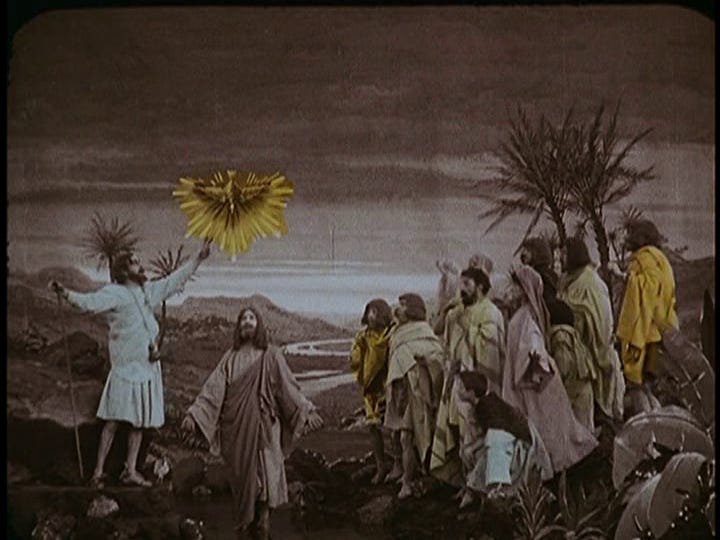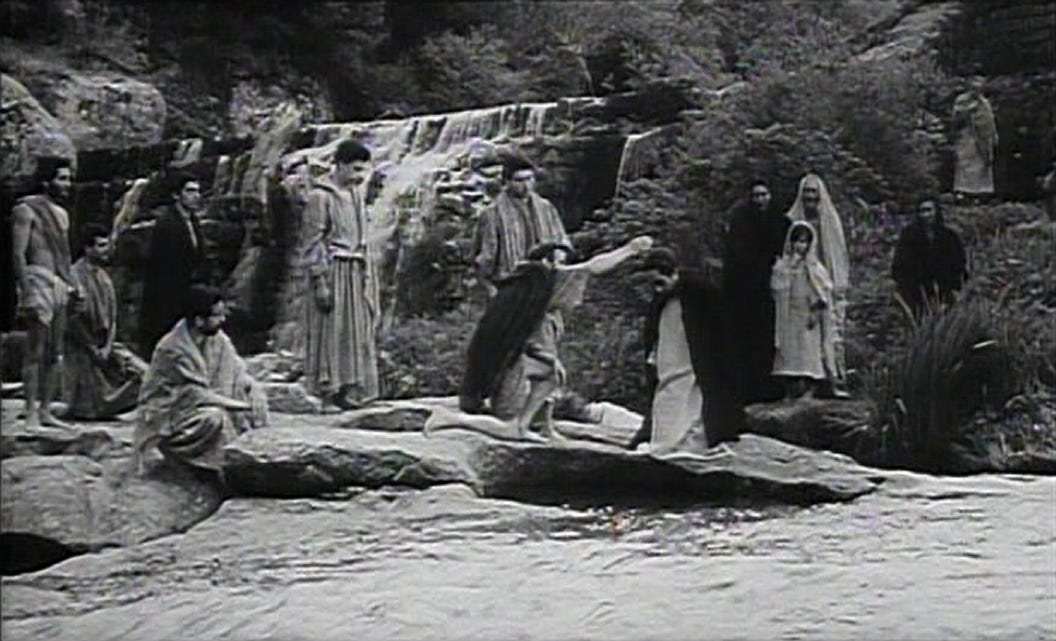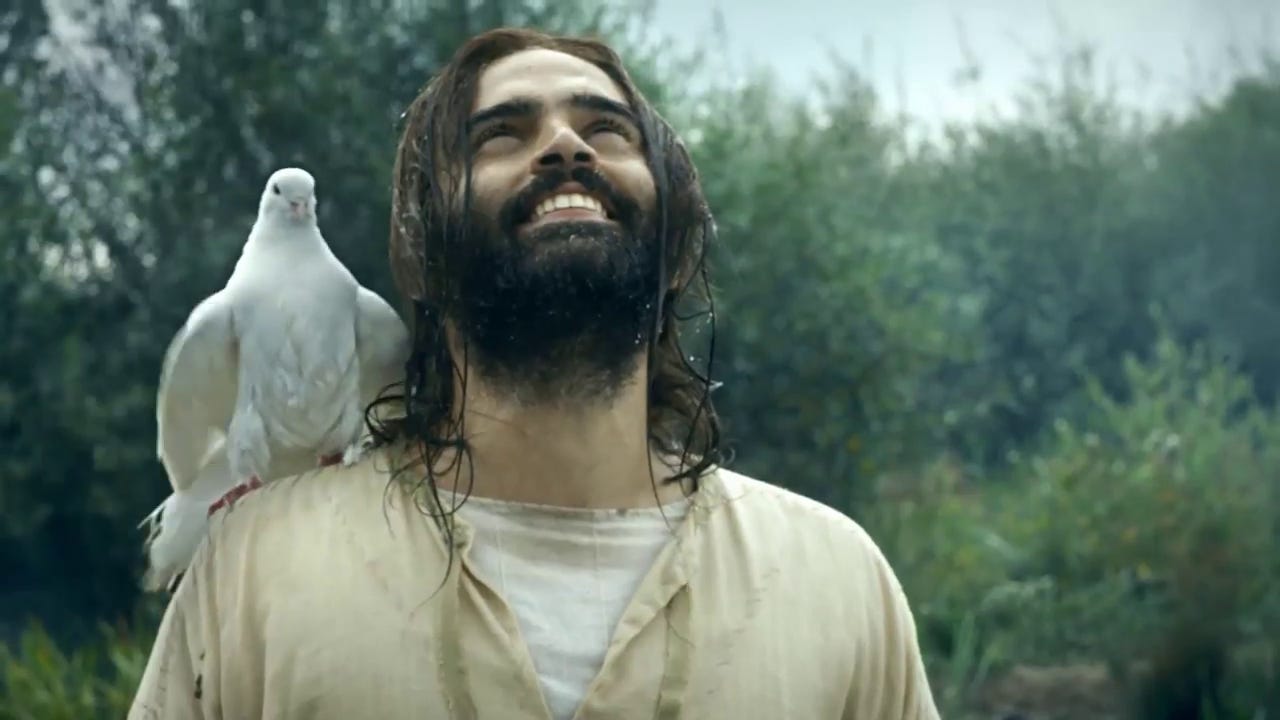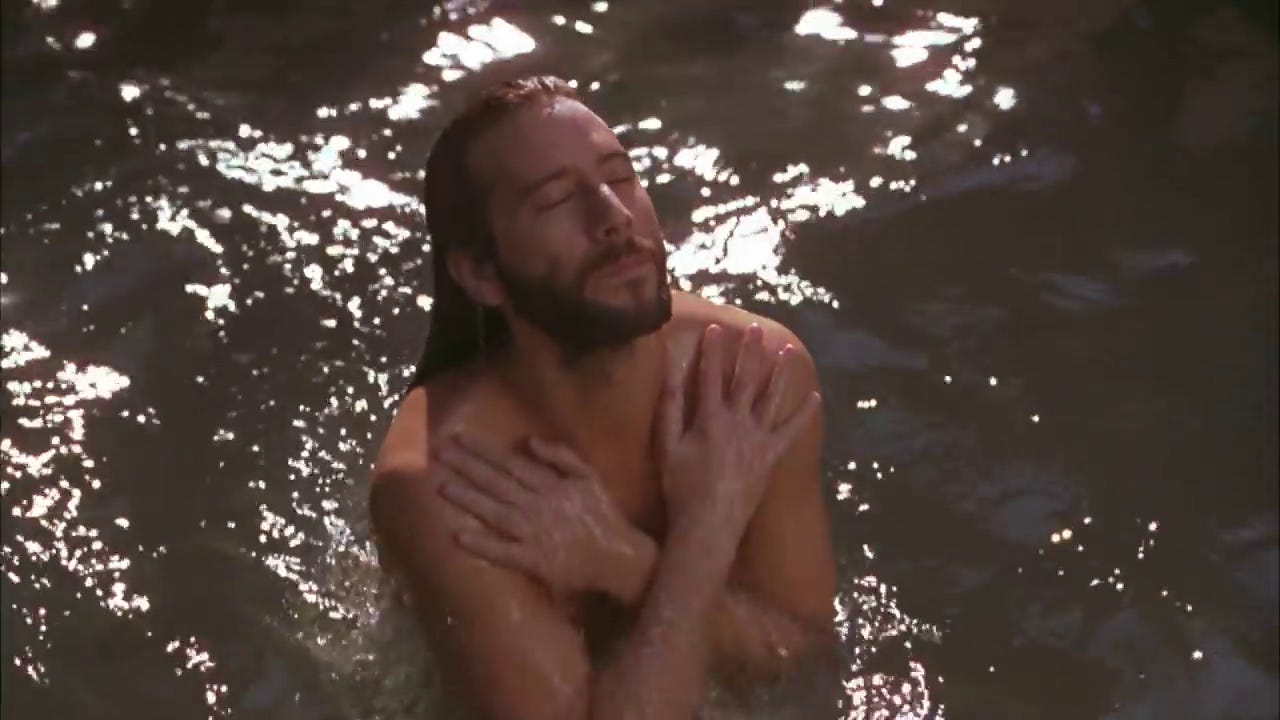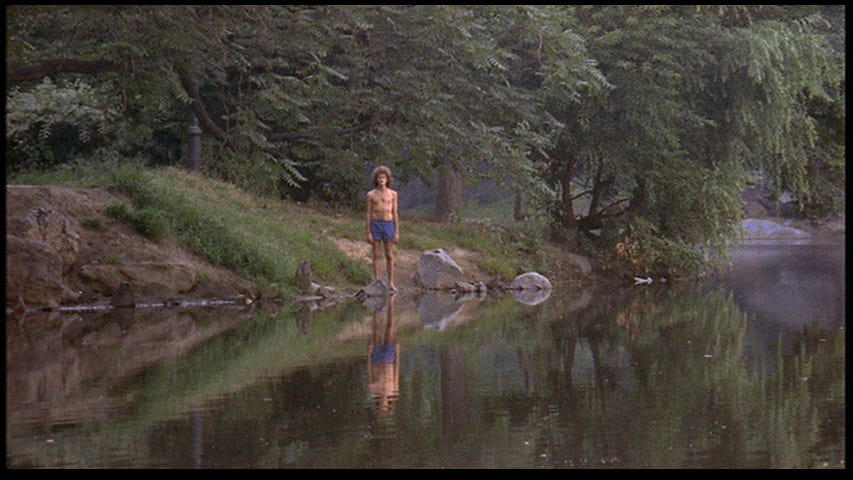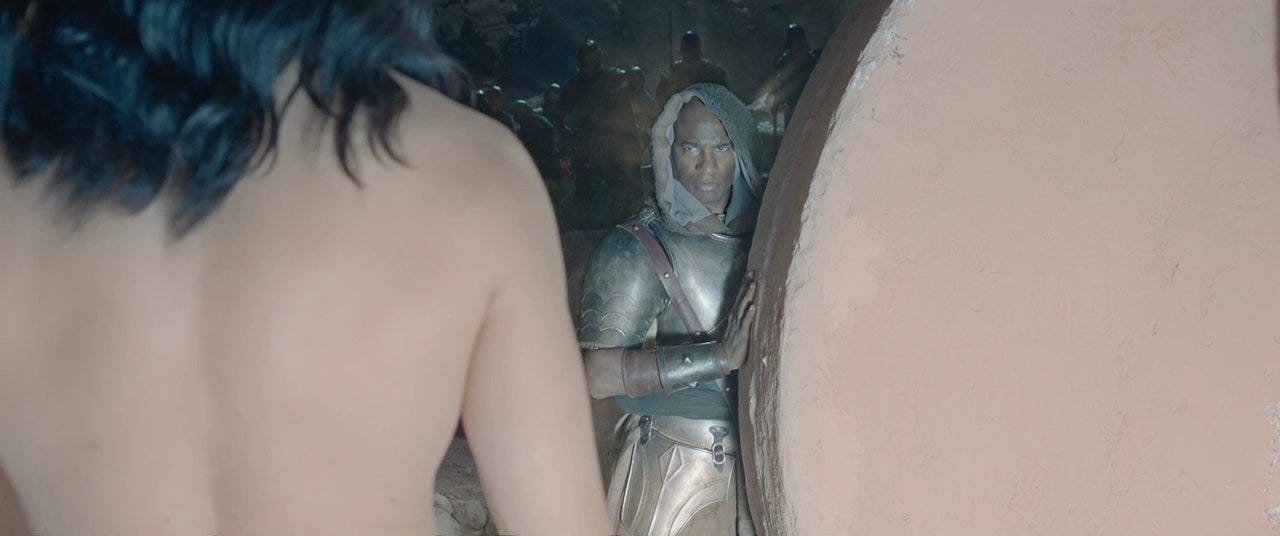Clothes, nudity, and baptism in Jesus movies
The early Christians were baptized naked. Jesus himself is naked in some of the icons depicting his baptism. But very few films have dared to go that route.

Ten years ago, I wrote a blog post on the use of nudity in Jesus films.
In that post, I looked at a few films in which Jesus appears naked at three key times in his life—his birth (The Nativity Story, 2006), his crucifixion (The Last Temptation of Christ, 1988), and his resurrection (The Passion of the Christ, 2004)—and I laid out the historical, traditional, and artistic reasons for depicting Jesus that way.1
Along the way, I mentioned that there was one other part of Jesus’ story where he arguably ought to be depicted naked, but to my knowledge no film had ever done that: namely, his baptism. As I noted in that post, the early Christians were baptized in the nude, so it would make sense if Jesus was baptized in the nude, too.
Today, to mark the Feast of the Theophany—when Eastern Orthodox Christians celebrate the Trinity’s self-revelation at the baptism of Jesus—I would like to explore this subject a little further. Below, I will look at the artistic and cultural factors that support the depiction of Jesus as naked at his baptism, and I will look at how some of the better-known Jesus movies have handled this aspect of his baptism.
The nudity of Jesus in traditional iconography
Whenever Jesus strips down in a work of art, he often keeps his loincloth on. You see it in artistic representations of his crucifixion, and you see it with his baptism, too. But in the eastern tradition, at least, it is not uncommon to find icons in which Jesus is essentially naked for his baptism, even if the nudity is obscured somewhat.
See, for example, this icon from my own church:


Do icons like these tell us anything about the historical baptism of Jesus, and whether he was naked at the time? Not necessarily. It is possible that artists and iconographers started portraying the baptism this way so that Christians—who were, themselves, being baptized in the nude—could see their own experience reflected in Jesus.
Either way, the point here is that there is definitely a religious and artistic precedent for depicting Jesus’ baptism this way, if any filmmaker wanted to go that route.
Before baptism, there were mikvehs
Many scholars believe that baptism basically grew out of the Jewish tradition of bathing in a mikveh for ritual purification. Bathing in a mikveh is something that one does on a recurring basis, but it can also signify conversion to Judaism, and John the Baptist adapted the practice and turned it into a rite of passage for his followers, which was then adopted by Jesus himself during his ministry (John 3:22, 4:1-2), and was then carried over into the early Christian movement (Acts 2:38, etc.).
And, significantly, Jewish tradition requires that people enter the mikveh naked.
There are at least a couple of Bible films that depict mikvehs being used this way.
Chief among these is The Genesis Project’s adaptation of the Gospel of Luke (filmed between 1976 and 1979), which shows Jesus’ mother Mary bathing in a mikveh to purify herself after giving birth (as per the “purification rites” in Luke 2:22):
After Mary immerses herself in the water in the close-up above, there is a wider shot in which she begins to rise from the mikveh and we see her bare back from behind—but as soon as the film cuts to that shot, it dissolves to a completely different scene, so that even that hint of tasteful nudity is obscured by an overlapping image.
As for other films, the Old Testament series Of Kings & Prophets (2016) shows Saul’s daughter Merav entering a mikveh naked as part of her wedding prep.
And… that’s all that comes to mind right now.
I can think of a few other films that have shown biblical characters using mikvehs, but the characters in those films tend to do so with their clothes on. A trailer for The Chosen, for example, indicates that Simon Peter’s wife Eden might be using a mikveh in an upcoming episode—but if she does, she’ll be doing so fully covered:2
How fully clothed is Jesus when he’s baptized in the movies?
From Cecil B. DeMille’s The King of Kings (1927) to the hit streaming show The Chosen, many Jesus movies start at some point in the middle of his ministry and skip his baptism altogether. A few even skip his ministry and go straight to the crucifixion.
But many Jesus movies do depict his baptism, and in most of them, he is fully clothed when it happens—though how many layers he wears varies from film to film.
The images below are a very, very partial sampling of the higher-profile films:
Of all the films I checked while writing this post, only three showed Jesus even partly nude at his baptism.
Two of them show Jesus actively stripping down to his loincloth on-camera.
The first of those is Roberto Rossellini’s The Messiah (1975):
In this film, Jesus is basically just one of many men who strip down to their loincloths to be baptized by John. There is a bit of dialogue, taken from Matthew’s gospel, in which John briefly protests that he should be baptized by Jesus rather than vice versa, but there is no dove coming down from heaven and no declaration from above that Jesus is God’s beloved son. The one subtle difference is that Jesus kneels before John the Baptist, whereas all of the other men are baptized standing up.3
The other film that shows Jesus disrobing on-camera is The Last Temptation of Christ (1988)—which, interestingly, was directed by Rossellini’s ex-son-in-law:
This sequence is interesting, for a couple of reasons:
First, this film depicts John the Baptist as the leader of a sort of religious-ecstatic movement whose members beat drums, chant, and dance by the edge of the river—and some of John’s followers are completely naked. So Jesus, standing there in his loincloth, falls somewhere in the middle of that crowd clothing-wise, between those who are fully clothed and those who are completely naked.
And second, as is typical of a Hollywood film, John’s naked female followers are fully exposed to the camera, but John’s naked male followers are not—or, rather, a few of the male followers were exposed to the camera, but their private parts are obscured by smudges on the film print. (No, I won’t post any screen captures of that here.) It’s a subtle effect, but it’s there, at least on the Criterion DVD.
One other interesting detail, which The Messiah and The Last Temptation of Christ have in common: Even though Jesus strips down to his loincloth, he is never fully immersed in the water, the way Jews fully immerse themselves in the mikveh or the way Christians are baptized in many churches; instead, only his head gets wet, as per the mode of baptism practiced in some modern western churches.4
The third film I checked in which Jesus is baptized at least partly nude—and he may be fully nude, under the water—is The Visual Bible: The Gospel of John (2003).
This scene is curious for a few reasons:
First, Jesus is the only person in this film who isn’t fully covered when he is baptized. For comparison, here is a wide shot from another scene in the film that shows John’s followers during and after their baptisms:
Second, Jesus seems to baptize himself, without John the Baptist’s help.5
And finally, John’s gospel never actually mentions Jesus’ baptism—it’s the only gospel that doesn’t mention it—so there was arguably no need to film this scene in the first place!6
Basically, this is an act of harmonization: The filmmakers have taken an image of Jesus’ baptism from the other gospels and put it onscreen while, on the soundtrack, John the Baptist talks about Jesus and the Holy Spirit using the words of John’s gospel.
But the image and the words are not connected to one another, and that disconnect is underlined by the contents of the image: Jesus seems to self-baptize, unlike everyone else; and Jesus isn’t wearing any visible clothes, unlike everyone else.
So there is a sense here in which the baptism of Jesus is different from everyone else’s baptism—and his nudity, partial or full, serves to underline that difference.
Bonus thought: shirts come and go at the fountain in Godspell
My main focus above has been films that depict the baptism in its historical setting, in first-century Palestine. But I couldn’t resist taking a look at one film that moves the gospel story to present-day New York, i.e. the musical Godspell (1973).
This film begins with John the Baptist summoning his followers and leading them to the Bethesda Fountain in Central Park,7 where they splash each other with water:
At one point, John looks to the side and sees Jesus standing there, shirtless:
As John’s followers leave the fountain, one tosses his shirt in the air, another takes off his shoes, another takes off her apron, another dumps her purse in a trash bin…
Meanwhile, Jesus runs to the fountain, shouting, “I wanna get washed up!” And then, after a brief exchange, John baptizes Jesus, who starts to sing a song…
…and then, in mid-song, we cut to a different angle—a close-up on Jesus’ face—and as we zoom out, we see that Jesus is now fully clothed:
So John the Baptist’s followers remove items of clothing, as part of how they turn away from their old lives, while Jesus magically acquires clothing, presumably as a sign of his newly-inaugurated messianic mission (as interpreted by this musical).
So, again, even without the Holy Spirit coming down like a dove or anything like that, the baptism of Jesus in this film is clearly different from all the other baptisms. And that difference is signified, in part, by who’s wearing clothes and when.
And… that about covers it. Did I miss any films? If so, please let me know.
Since I wrote that post, there has been another film that showed Jesus coming out of the tomb naked: Resurrection (2021), a feature-length re-edit of the first four episodes of A.D. The Bible Continues (2015) that includes some brand-new footage.
In my post on nudity in Jesus films, I also made a few points about the circumcision scene in Jesus of Nazareth (1977). I later wrote an entire post on depictions of the circumcision of Jesus in film, and one of the films I highlighted there, the Arabic film The Savior (2014), features a close-up of Jesus’ foreskin being dropped into a bowl, which is arguably a kind of nudity, at least insofar as it concerns a body part that is normally kept hidden.
The Chosen’s reluctance to show even partial nudity extends to its depiction of crucifixion. Some of the crucifixees in Season 2 Episode 4 are fully clothed on their crosses.
I want to thank Matt Page for reminding me about this film as I was writing this.
It’s particularly curious that Jesus, in The Last Temptation of Christ, drops his robe right into the river. His body may have stayed dry during his baptism, but his clothes didn’t!
Jesus baptizing himself, instead of submitting to baptism at John the Baptist’s hands, is actually kind of in keeping with the rest of John’s gospel. See, for example, how all the other gospels say Simon of Cyrene carried Jesus’ cross—presumably because Jesus was too weak after his torture to carry it by himself—whereas John’s gospel says Jesus carried it.
The Lumo Project—the only word-for-word adaptation of all four gospels—also uses footage of Jesus’ baptism in its adaptation of John’s gospel, despite the fact that the gospel itself never actually mentions the baptism. The shot I posted from The Lumo Project above is used in all four of their word-for-word adaptations of the gospels.
Ironically, this fountain is named after the Pool of Bethesda from John 5:1-15, and the statue on top of it represents the angel that, in some manuscripts, stirred the water to give it healing powers. I say “ironically” because the story concerns a paralytic who was healed by Jesus so he wouldn’t have to go into the pool to be healed. Baptism is about going into the water, but the Bethesda story is about someone who didn’t go into the water.





